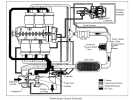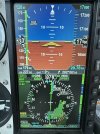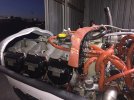I’m looking at some aircraft and I’m interested in this one that has turbo and I sent the listing to my mechanic and he’s having a heart attack about the airframe hours (5000) and the fact that it has a turbo. The higher altitudes and speed are very appealing to me. Got any tips suggestions feedback on this?
You are using an out of date browser. It may not display this or other websites correctly.
You should upgrade or use an alternative browser.
You should upgrade or use an alternative browser.
Why is my mechanic so against a turbo?
- Thread starter mandm
- Start date
Checkout_my_Six
Touchdown! Greaser!
Probably because he doesn't know what to do with a turbo.....take it as a warning.....you will pay him to learn or you'll be getting a new mechanic. 
Pinecone
En-Route
Turbos can have more maintenance and you need to pay attention to operating them properly.
But I would not want to own a traveling plane that wasn't turbo.
I wrote an article about the positives for Mooney Flyer. https://themooneyflyer.com/issues/2023-AugTMF.pdf
But I would not want to own a traveling plane that wasn't turbo.
I wrote an article about the positives for Mooney Flyer. https://themooneyflyer.com/issues/2023-AugTMF.pdf
Klaus M
Pre-takeoff checklist
Check the overhaul price of a turbocharged engine. If the price doesn't scare you, then Go-For-It. A friend had a turbocharged Piper Saratoga with a TIO-540-S1AD and the factory was not going to overhaul it but changed their mind and charged $115,000.00. Then Lycoming said they will never do it that cheap again.


The concern your mechanic has might be more related to the specific aircraft type than it is with turbos in general. But as has already been mentioned, there is the potential for added maintenance expense.
There may be minimal performance return on having a turbo depending on the aircraft, where you live, and the kind of flying you're doing.
There may be minimal performance return on having a turbo depending on the aircraft, where you live, and the kind of flying you're doing.
schmookeeg
En-Route
Because you'll be wanting a new mechanic to go along with that new turbo whip.
Pinecone
En-Route
But do you plan on flying in the west?Midwest based. Less need for a turbo and more maintenance.
Do you like the idea of climbing higher to take advantage of a nice tailwind? And higher is faster due to TAS gain.
Attachments
As to the turbo side, I can understand from a mx point. I tended to stay away from turbos and retracts for various reasons, but I had the flexibility to do so. However, if a 5000TT airframe is giving him heartburn, then there is probably more to the story. I've worked on 30K+ TT airframes and never blinked an eye. Perhaps sit down with him and ask him the real reasons why? I would have welcomed to the opportunity to explain my reasons why to an owner.Got any tips suggestions feedback on this?
Tarheelpilot
Final Approach
- Joined
- Dec 5, 2010
- Messages
- 7,506
- Location
- North Carolina once again.
- Display Name
Display name:
Tarheelpilot
Turbos are not free. If you need the performance then you should get the turbo airplane. If you don’t fly in a manner that will take advantage of the turbo you would be dumb to spend the money.
Personally I would never buy a plane that’s turbocharged. Not because they are inherently bad but because I do not need or want the capability they add. It would be nothing but added costs for me.
Personally I would never buy a plane that’s turbocharged. Not because they are inherently bad but because I do not need or want the capability they add. It would be nothing but added costs for me.
Non Compos Mentis
Pre-takeoff checklist
- Joined
- Dec 15, 2012
- Messages
- 319
- Display Name
Display name:
Non Compos Mentis
My mechanic hates a turbo Mooney.
Not because of the maintenance required, but because of the difficulty.
Mooney packed an entire airplane into a small, tidy package.
Add a turbo, and even an oil change becomes a headache working among all the bits & pieces with no room for fingers in between.
Not because of the maintenance required, but because of the difficulty.
Mooney packed an entire airplane into a small, tidy package.
Add a turbo, and even an oil change becomes a headache working among all the bits & pieces with no room for fingers in between.
PaulS
Touchdown! Greaser!
How has your dispatch been with the turbo? Relatively new to a bravo here.But do you plan on flying in the west?
Do you like the idea of climbing higher to take advantage of a nice tailwind? And higher is faster due to TAS gain.
Tarheelpilot
Final Approach
- Joined
- Dec 5, 2010
- Messages
- 7,506
- Location
- North Carolina once again.
- Display Name
Display name:
Tarheelpilot
I hate working on Mooneys. Period. They are awesome to fly but they are ten pounds of **** in a five pound sack. The only airplane I dislike more is the duke. Those turbo 541 engines are a P.I.T.AMy mechanic hates a turbo Mooney.
Not because of the maintenance required, but because of the difficulty.
Mooney packed an entire airplane into a small, tidy package.
Add a turbo, and even an oil change becomes a headache working among all the bits & pieces with no room for fingers in between.
Checkout_my_Six
Touchdown! Greaser!
The airplane type is offered in both NA and turbo versions, my mechanic is fine with a NA version but I kind of want the altitude to fly in the flight levels solely for purpose of taking advantage of tailwinds, also the added speed and climb performance when going on xc flights.
A 3-4 hour flight is a big difference compared to a 5-6 hour flight especially if you want to go somewhere for a long weekend. Longer journeys take me longer to recover and to get to my holiday enjoyment status mode.
I almost want to create another which airplane to buy thread want something faster than the Arrow, but like the other m says, the Arrow works, why risk a new airplane for marginal gains in speed, BUT we need to get there faster.
want something faster than the Arrow, but like the other m says, the Arrow works, why risk a new airplane for marginal gains in speed, BUT we need to get there faster.
A 3-4 hour flight is a big difference compared to a 5-6 hour flight especially if you want to go somewhere for a long weekend. Longer journeys take me longer to recover and to get to my holiday enjoyment status mode.
I almost want to create another which airplane to buy thread
MauleSkinner
Touchdown! Greaser!
But overall it may not be, depending on climb and descent speeds.And higher is faster due to TAS gain.
MauleSkinner
Touchdown! Greaser!
Look at the manufacturer’s numbers for climb and descent before you assume the trip will be 25-30% shorter. Last one I did the math on was 3 minutes faster at FL180 than 4000 ft from Minneapolis to Oklahoma City.A 3-4 hour flight is a big difference compared to a 5-6 hour flight
Klaus M
Pre-takeoff checklist
@mandm, This is why they created "Fractional Aircraft Ownership". I believe you'll be very surprised by the cost and the opportunities to do your own flying. Sometimes things work out and you may find yourself hiring on as an eligible pilot.The airplane type is offered in both NA and turbo versions, my mechanic is fine with a NA version but I kind of want the altitude to fly in the flight levels solely for purpose of taking advantage of tailwinds, also the added speed and climb performance when going on xc flights.
A 3-4 hour flight is a big difference compared to a 5-6 hour flight especially if you want to go somewhere for a long weekend. Longer journeys take me longer to recover and to get to my holiday enjoyment status mode.
I almost want to create another which airplane to buy threadwant something faster than the Arrow, but like the other m says, the Arrow works, why risk a new airplane for marginal gains in speed, BUT we need to get there faster.

Fractional Ownership
Fractional Aircraft Ownership, a share is contractually-defined and allows an undivided interest of a single aircraft to be sold to multiple owners on the basis of 800 occupied hours per year and sold in fractions as small as one sixteenth
 nbaa.org
nbaa.org
Checkout_my_Six
Touchdown! Greaser!
The most important parameter with a turbo is fuel flow.....adequate fuel flow and the engine will perform and run cool in extended climbs. If there isn't enough....the CHTs will be screaming hot and you'll be burning exhaust valves.
Zeldman
Touchdown! Greaser!
What most folks call turbocharged is really turbo normalized. But there are turbo/super charged engines out there.Are turbo normalized setups as bad maintenance wise a turbo's?
Ham fisted pilots will do more damage to a turbo engine than normal operations. I have seen pilots new to turbos go through cylinders before they learn how to operate the throttle(s) properly.
A turbo adds some complications and potential costs. OTOH being able to fly higher let’s you take advantage of some nice tail winds, can get you over weather and offers higher TAS. If fuel controller is set up properly, there’s nothing difficult to operating a turbo.
I’ve been operating two turbos for over 7 years now. Very glad to have them. YRMV
I’ve been operating two turbos for over 7 years now. Very glad to have them. YRMV
MooneyDriver78
En-Route
- Joined
- Aug 13, 2013
- Messages
- 4,691
- Display Name
Display name:
Tom
To take advantage of the turbo capabilities you need O2 tanks, pressurized magnetos; don’t know if they are a significant maintenance expense. I thought the O2 tanks have to be tested every 5-10 years?
People often forget the difference of 130ktas to a 160ktas is a matter of a few minutes. A piston single vs another piston single will hardly ever gain an hour, much less a couple. I agree.Look at the manufacturer’s numbers for climb and descent before you assume the trip will be 25-30% shorter. Last one I did the math on was 3 minutes faster at FL180 than 4000 ft from Minneapolis to Oklahoma City.
Grum.Man
En-Route
You’d have to do a lot of serious cross
Country trips to justify a turbo. What type
Of plane are you looking at? Maybe there is a different model that provides the same capability as the turbo model you are looking at. For example a 550 powered Mooney probably provides similar or better performance than a turbo 231. In my opinion if you are doing enough cross country work to justify a turbo you’d probably be best served by something pressurized. A turbo certainly makes sense though if you routinely fly in the Rockies.
Country trips to justify a turbo. What type
Of plane are you looking at? Maybe there is a different model that provides the same capability as the turbo model you are looking at. For example a 550 powered Mooney probably provides similar or better performance than a turbo 231. In my opinion if you are doing enough cross country work to justify a turbo you’d probably be best served by something pressurized. A turbo certainly makes sense though if you routinely fly in the Rockies.
Let'sgoflying!
Touchdown! Greaser!
In addition to high altitude flying benefits, there is the ‘lessening of anxiety’ when departing hi DA airports.
Dan Thomas
Touchdown! Greaser!
- Joined
- Jun 16, 2008
- Messages
- 11,360
- Display Name
Display name:
Dan Thomas
You can get too much boost if the engine isn't handled properly, especially in manual wastegate systems, where the wastegate is linked to the throttle. That high induction pressure can lead to detonation, which trashes cylinders. It shatters rings, cracks pistons and heads.Can you expand on this a bit?
Exhaust systems suffer in turboed airplanes, and exhaust systems are not cheap. The back pressure caused by the turbo raises the exhaust system temperatures. A few years ago an AD came out on the newer Cessna T206H airplanes; the exhaust systems needed an inspection to see if the pipes were sagging and distorting. The pipes were getting so hot that the mounting flanges at the cylinder heads were softening and bending and leaking. I found that on the two front cylinders of one of those airplanes. The new pipes weren't cheap, I tell you. Aircraft exhaust systems are often operating red-hot, and turboed systems even more so.
Morgan3820
Ejection Handle Pulled
I think you should buy it. It’s not my money. All I know is that when I was looking my mechanic didn’t want me to get a turbo either. I had a friend who had a turbo cracked two cylinders on the same flight. But he still thought he wanted to fly higher. He couldn’t get anybody to partner with him because of the extra maintenance. He ended up selling it because of a looming overhaul. I know that is anecdotal. Having turbos kind of like four-wheel-drive on a pick up. Unless you really need it it’s just an extra expense.
Last edited:
Clip4
Touchdown! Greaser!
I’m looking at some aircraft and I’m interested in this one that has turbo and I sent the listing to my mechanic and he’s having a heart attack about the airframe hours (5000) and the fact that it has a turbo. The higher altitudes and speed are very appealing to me. Got any tips suggestions feedback on this?
About every mechanic I have ever spoken to will recommend against a turbocharged engine unless you live in the mountain west and really need a turbo charged airplane.
Here is a link to an articles discussing some of the issues.

Turbocharger Troubleshooting 101
Contrary to popular belief, with the right combination of preventative care and proper maintenance, turbochargers are an extremely reliable and trouble-free piece of equipment...

Turbo Troubles - Aviation Safety
The turbocharger is a useful part of a pilots toolbag. When flying an airplane with one installed, it can increase our rate of climb, boost our groundspeed and lift us above a lot of the weather. It also can be used to pressurize the airplanes cabin, allowing us to enjoy a shirtsleeve...
Clip4
Touchdown! Greaser!
I’m looking at some aircraft and I’m interested in this one that has turbo and I sent the listing to my mechanic and he’s having a heart attack about the airframe hours (5000) and the fact that it has a turbo. The higher altitudes and speed are very appealing to me. Got any tips suggestions feedback on this?
About every mechanic I have ever spoken to will recommend against a turbocharged engine unless you live in the mountain west and really need a turbo charged airplane.
Here is a link to an article from aviation safety that discusses some of the issues.

Turbo Troubles - Aviation Safety
The turbocharger is a useful part of a pilots toolbag. When flying an airplane with one installed, it can increase our rate of climb, boost our groundspeed and lift us above a lot of the weather. It also can be used to pressurize the airplanes cabin, allowing us to enjoy a shirtsleeve...
The 252 is on the top of my list of turbocharged aircraft I would own.My mechanic hates a turbo Mooney.
Not because of the maintenance required, but because of the difficulty.
Mooney packed an entire airplane into a small, tidy package.
Add a turbo, and even an oil change becomes a headache working among all the bits & pieces with no room for fingers in between.
Morgan3820
Ejection Handle Pulled
Or some really nice headwinds.A turbo adds some complications and potential costs. OTOH being able to fly higher let’s you take advantage of some nice tail winds, can get you over weather and offers higher TAS. If fuel controller is set up properly, there’s nothing difficult to operating a turbo.
I’ve been operating two turbos for over 7 years now. Very glad to have them. YRMV
At first, I didn't believe this. I paid 88,000 for this engine rebuilt in November 2021, which is now going for 114,000.Check the overhaul price of a turbocharged engine. If the price doesn't scare you, then Go-For-It. A friend had a turbocharged Piper Saratoga with a TIO-540-S1AD and the factory was not going to overhaul it but changed their mind and charged $115,000.00. Then Lycoming said they will never do it that cheap again.

WTH is going on!!??
Had the same plane as a turbo and as a NA (A36TC vs. A36).
- Engine is far more reasonable to overhaul on the NA
- Maintenance on anything behind the engine is much easier without all the tubing
- Better mpg for the NA
- The difference in speeds was not transformational. You can burm more fuel to fly faster at altitude, but there is no magic to it
We didn't have many turbo specific maintenance issues. Took a few different mechanics to get the fuel flow just right on that narrow ledge between hot CHTs and losing power from being overly rich.
One of the partners in the turbo plane took it out west to AZ and CA every summer. For those trips, the turbo was a very helpful tool.
- Engine is far more reasonable to overhaul on the NA
- Maintenance on anything behind the engine is much easier without all the tubing
- Better mpg for the NA
- The difference in speeds was not transformational. You can burm more fuel to fly faster at altitude, but there is no magic to it
We didn't have many turbo specific maintenance issues. Took a few different mechanics to get the fuel flow just right on that narrow ledge between hot CHTs and losing power from being overly rich.
One of the partners in the turbo plane took it out west to AZ and CA every summer. For those trips, the turbo was a very helpful tool.
Then fly lower. That’s the advantage of the turbo. Pilot can fly low or high.Or some really nice headwinds.
PaulS
Touchdown! Greaser!
Money is becoming worthless.At first, I didn't believe this. I paid 88,000 for this engine rebuilt in November 2021, which is now going for 114,000.
WTH is going on!!??
"A nickel ain't worth a dime anymore"Money is becoming worthless.
-Yogi Berra
Dan Thomas
Touchdown! Greaser!
- Joined
- Jun 16, 2008
- Messages
- 11,360
- Display Name
Display name:
Dan Thomas
Some turbo systems are automated. Fully-mechanical, though, since electric stuff tends to fail too often. This system has been around a long time. Go here and read about it:This seems to be a case where a well-executed closed-loop engine management system would pay real dividends in both efficiency and safety. Airplanes are a more complex environment than ground vehicles, but the same basic principles apply, and ground vehicle engines have had this for decades.
https://www.extraaircraft.com/docs/tech-manuals/MM400/81r1.pdf
A diagram of the system:

Some systems don't have the sloped controller, but the rest is there and watches that overboosting doesn't happen. However, since the system uses a metered oil pressure "leak" to control the wastegate, taking off with the oil still cold, and just jamming the throttle all the way forward, can result in overboost before the wastegate can open to limit the boost. One still has to think, just like with the rest of aviation. The world of airplanes is not for non-thinkers.
Cars have become so automated that one doesn't need to know anything (the thinking goes), and that results in people trusting the machine to the point that it kills them. Barrelling along the freeway on the ice, for instance, thinking that the ABS and stability augmentation and all-wheel-drive makes it safe. It's stupid, not safe. One still has to think about the machine's limitations.
More on turbo systems:
https://www.aviationpros.com/home/a...-turbocharging-part-ii-valves-and-controllers
Last edited:
Zeldman
Touchdown! Greaser!
I should of been more explicit. Dan Thomas explained it well. Just to add:Can you expand on this a bit?
What I saw and dealt with was pilots yanking the throttle around too much. Over boosting on take offs and yanking the throttles back 10 inches to start descending. Company standard procedure at companies I worked at was when reducing power, starting off with reducing MP 3 inches 5 minutes before starting the descent, then 1 inch a minute. We would get new hires that never flew turbo charged engines then treat them like they were in a 152 and go from cruise throttle setting to idle to descend. Improper procedures will cause cracks in cylinders. I might have done a couple in myself...
I never flew a manual wastegate, everything I was in had an automatic wastegate, but I can see that improper procedures with that would cause damage as well.
Checkout_my_Six
Touchdown! Greaser!
So the turbo causes cylinders to crack?


